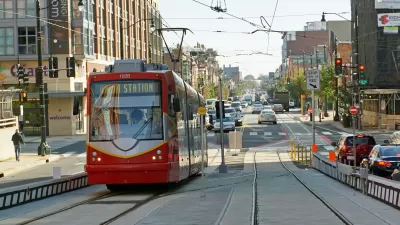Under the new guidelines, developers will need to implement specific community engagement strategies, at times based on a neighborhood's demographics.

Seattle wants to make it easier for residents to learn about developers' plans in their area. "Often in the design process," Stephen Fesler writes, "developments move to local design review boards where the proposals are seen for the first time and are well set in their direction having had little or no community feedback."
A new set of guidelines, in effect starting this month, "requires applicants with projects participating in the design review process to develop early community engagement plans and then execute them in their local neighborhoods."
The plans "must include a mix of printed, digital, and in-person mediums to obtain community feedback." On top of that, developers who want to build in certain census tracts, dubbed "equity areas," will need to work with the Seattle Department of Neighborhoods (DON) to create custom engagement plans.
Fesler writes that "DON has tried to make the process for community engagement easy and cheap for applicants. A centralized, special website has been purpose built for the program, serving both community and applicants." Note that while developers must seek out community feedback, they aren't required to incorporate it into their intended designs prior to submitting for review.
See also: Seattle Planning Director Pursues Equity Amid a Pro-Growth Agenda
FULL STORY: Seattle Hopes Early Community Engagement Will Help Shape Design

Alabama: Trump Terminates Settlements for Black Communities Harmed By Raw Sewage
Trump deemed the landmark civil rights agreement “illegal DEI and environmental justice policy.”

Planetizen Federal Action Tracker
A weekly monitor of how Trump’s orders and actions are impacting planners and planning in America.

The 120 Year Old Tiny Home Villages That Sheltered San Francisco’s Earthquake Refugees
More than a century ago, San Francisco mobilized to house thousands of residents displaced by the 1906 earthquake. Could their strategy offer a model for the present?

Opinion: California’s SB 79 Would Improve Housing Affordability and Transit Access
A proposed bill would legalize transit-oriented development statewide.

Record Temperatures Prompt Push for Environmental Justice Bills
Nevada legislators are proposing laws that would mandate heat mitigation measures to protect residents from the impacts of extreme heat.

Downtown Pittsburgh Set to Gain 1,300 New Housing Units
Pittsburgh’s office buildings, many of which date back to the early 20th century, are prime candidates for conversion to housing.
Urban Design for Planners 1: Software Tools
This six-course series explores essential urban design concepts using open source software and equips planners with the tools they need to participate fully in the urban design process.
Planning for Universal Design
Learn the tools for implementing Universal Design in planning regulations.
Clanton & Associates, Inc.
Jessamine County Fiscal Court
Institute for Housing and Urban Development Studies (IHS)
City of Grandview
Harvard GSD Executive Education
Toledo-Lucas County Plan Commissions
Salt Lake City
NYU Wagner Graduate School of Public Service





























